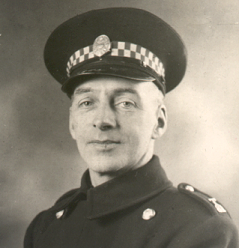Any member of the force who succumbs to temptation during the course of his duty is subject to the same relentless investigation as any other law-breaker. Constable James Ronald Robertson of the Southern division, Glasgow Police, was such a man and from the moment he became suspect no effort was spared to prove his guilt.

Constable Robertson (33), known as ‘Big Ronnie’, was carrying on a relationship with a single mother, Catherine McCluskey (42), on his beat in the Cumberland Street area of Glasgow. She claimed to friends that the father of the youngest of her two children was a police officer whose surname was Robertson.
He was already married with two children and in July, 1950, he decided to end the relationship with Catherine as he was paying her money each week.

On 28 July, 1950, Robertson was on night duty but left his beat. He got a car which he had stolen several weeks earlier, and picked up Catherine McCluskey near her house. He drove around for some time with Catherine McCluskey, during which time she asked him for money for her rent and they argued.
A short time later, Robertson stopped the car in Prospecthill Road and they both got out of the car. During the continuing argument, it was alleged that he struck Catherine with a rubber truncheon knocking her down, then ran the car over her body twice with the wheels. He then drove back to his beat and resumed his patrol.
About 12.10 am on 29 July, her body was found lying on the roadway on Prospecthill Road by a taxi driver. As it had been reported to the police as an apparent hit-and-run road accident, Constable William Kevan of the Traffic Department was radioed to attend the scene and investigate.

Traffic Department
From marks on the road and from the severe nature of the woman’s injuries he was convinced that she had been run over more than once. Consequently, Constable Kevan radioed for the C.I.D. to attend and within hours medical and forensic experts confirmed his judgement. This was murder by motor car.
Constable Robertson’s association with the woman was soon established and the car, a black Austin saloon, was impounded and examined. It was found to have been stolen from a lawyer and Robertson had found it abandoned on his beat. Instead of reporting the find, Robertson had fitted stolen number plates on it and had been using the car for several weeks, telling friends and colleagues that a friend had given him a long-term loan of the vehicle.
A forensic team, under the direction of Professor John Glaister of Glasgow University and Professor Andrew Allison, of St. Mungo’s College, examined the vehicle minutely and found ample evidence on its underside to connect him with the injuries on Catherine McCluskey’s body.

Robertson went on trial at Glasgow High Court on 6 November 1950, before Lord Keith and a jury of eight men and seven women. During his trial, his explanation of Catherine McCluskey’s death defied belief. Robertson denied murdering Catherine, saying instead that he did not know her well and gave her a lift. He said she wanted him to take her to Neilston, a round trip of 14 miles, but Robertson refused. She got out the vehicle and Robertson drove a short distance, then said he changed his mind. He said he reversed back and accidentally knocked her down. None of this explanation fitted with the forensic evidence.
The trial lasted a week and the jury deliberated only for one hour before returning the verdict of ‘Guilty’. Robertson was sentence to death by Lord Keith and, following a failed appeal and a rejected petition for a reprieve, at 8am on 16th December 1950, at Barlinnie Prison, hangman Albert Pierrepoint, assisted by Steve Wade, sent him to his doom, the only serving policemen to be executed in Britain in the 20th. century.
Copyright GPHS 2020
Sources: The Thin Blue Line by Douglas Grant (1973) and Police Review (4 December 1992)
